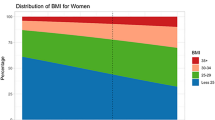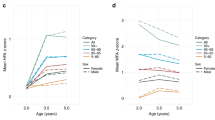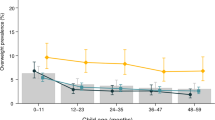Abstract
Objective:
To provide an overview of dynamic shifts in body mass index (BMI) and nutritional status patterns of the Vietnamese population from 1992 to 2002.
Design:
Nationally representative, cross-sectional surveys.
Setting and subjects:
Secondary data obtained from The Living Standard Survey in 1992 (24 068 individuals) and the National Health Survey in 2002 (158 019 individuals).
Methods:
Nutrition status was defined by comparing measured BMI, grouped for under- and overweight with the Centers for Disease Control and Prevention 2000 BMI growth charts for the 2–17 year-olds and the World Health Organization 1995 cutoff points for the 18–65 year-olds.
Results:
Over the 1992 and 2002 period, minimal changes were observed in the prevalence of overweight (from 1.4% (95% confidence interval (95% CI): 1.0–1.8) to 1.8% (1.6–2.0)) and underweight (from 32.1% (30.4–33.7) to 33.5% (32.8–34.1)) among 2–17 year-olds. In contrast, among 18–65 year-olds, the prevalence of overweight and obesity increased (from 2.0% (1.5–2.4) to 5.2% (5.0–5.4)) and underweight declined (from 32.6% (31.2–33.9) to 24.8% (24.3–25.3)). Urban residents experienced larger reductions in underweight and increases in overweight than rural residents. Analyses of BMI levels for the 15th, 50th and 85th percentiles, by age, revealed a trend of increasing BMI that was higher among adults, females and urban residents.
Conclusion:
Although underweight remains the main concern, overweight is an emerging problem in Vietnam. Early prevention is needed to prevent overweight from causing undesirable effects on health and economic in the transitional period.
Sponsorship:
Vietnam Educational Foundation (VEF) and the National Institutes of Health (NIH R01-HD30880 and R01-HD38700).
This is a preview of subscription content, access via your institution
Access options
Subscribe to this journal
Receive 12 print issues and online access
$259.00 per year
only $21.58 per issue
Buy this article
- Purchase on Springer Link
- Instant access to full article PDF
Prices may be subject to local taxes which are calculated during checkout




Similar content being viewed by others
References
ACC/SCN (2000). The 4th Report on The World Nutrition Situation: Nutrition Throughout the Lifecycle. Geneva.
Barker D (1998). Mothers, Babies and Health in Later Life. Churchill Livingstone: Glasgow.
Butte NF, Hopkinson JM (1998). Body composition changes during lactation are highly variable among women. J Nutr 128, 381S–385S.
de Onis M, Blossner M (2000). Prevalence and trends of overweight among preschool children in developing countries. Am J Clin Nutr 72, 1032–1039.
Department of Economic and Social Affairs (2005). Designing Household Survey Samples: Practical Guidelines. United Nations: New York.
Doak CM, Adair LS, Bentley M, Monteiro C, Popkin BM (2005). The dual burden household and the nutrition transition paradox. Int J Obes Relat Metab Disord 29, 129–136.
General Statistical Office (1994). Vietnam Living Standards Survey, 1992–1993. Statistical Publishing House: Hanoi.
Hanh TTM, Komatsu T, Hung NT, Chuyen VN, Yoshimura Y, Tien PG et al. (2001). Nutritional status of middle-aged Vietnamese in Ho Chi Minh City. J Am Coll Nutr 20, 616–622.
Hilson JA, Rasmussen KM, Kjolhede CL (2006). Excessive weight gain during pregnancy is associated with earlier termination of breast-feeding among white women. J Nutr 136, 140–146.
Hop le T, Xuan Ngoc TT (2004). Overweight/obesity situation and the relation to lipid disorders and hypertension in women aged 20 to 59 years old in Ba Dinh district, Hanoi City. Asia Pac J Clin Nutr 13, S139.
Hop LT, Gross R, Giay T, Schuntink W, Thuan BTN, Sastroamidjojo S (1997). Longitudinal observation of growth of Vietnamese children in Hanoi, Vietnam from birth to 10 years of age. Eur J Clin Nutr 51, 164–171.
Hop LT, Khan NC (2002). Malnutrition and poverty alleviation in Vietnam during the last period 1985–2000. Asia Pac J Clin Nutr 11, S331–S334.
Kuczmarski RJ, Ogden CL, Guo SS (2002). CDC growth charts for the United States: methods and development National Center for Health Statistics, Vital Health Stat 11, 246.
Lovelady CA, Garner KE, Moreno KL, Williams JP, Potter S, Hannum S et al. (2000). The effect of weight loss in overweight, lactating women on the growth of their infants. N Engl J Med 342, 449–453.
Ministry of Health – General Statistical Office (2003). The Report: Results of the Vietnam National Health Survey 2001–2002. Medical Publishing House: Hanoi.
Ministry of Health – National Institute of Nutrition (2003a). Dietary recommendation for the Vietnamese. Medical Publishing House: Hanoi.
Ministry of Health – National Institute of Nutrition (2003b). Nutrition survey 2002. Hanoi Publishing House: Hanoi.
National Centre for Social Sciences and Humanities (2001). National Human Development Report 2001: Doi Moi and Human Development in Viet Nam. Political Publishing House: Hanoi.
National Institute of Nutrition – General Statistical Office (2003). Vietnam Child and Mother Nutritional Status 2002. Medical Publishing House: Hanoi.
Popkin BM (2001). The nutrition transition and its implications for the fetal origins hypothesis. In: Barker D(ed). Fetal Origins of Cardiovascular and Lung Disease. Marcel Dekker: New York. pp 323–338.
Popkin BM (2002a). An overview on the nutrition transition and its health implications: the Bellagio meeting. Public Health Nutr 5, 93–103.
Popkin BM (2002b). The shift in stages of the nutrition transition in the developing world differs from past experiences!. Public Health Nutr 5, 205–214.
Popkin BM, Gordon-Larsen P (2004). The nutrition transition: worldwide obesity dynamics and their determinants. Int J Obes Relat Metab Disord 28, S2–S9.
Popkin BM, Horton S, Kim S, Mahal A, Shuigao J (2001). Trends in diet, nutritional status, and diet-related noncommunicable diseases in China and India: the economic costs of the nutrition transition. Nutr Rev 59, 379–390.
Popkin BM, Richards MK, Montiero CA (1996). Stunting is associated with overweight in children of four nations that are undergoing the nutrition transition. J Nutr 126, 3009–3016.
Sammel MD, Grisso JA, Freeman EW, Hollander L, Liu L, Liu S et al. (2003). Weight gain among women in the late reproductive years. Fam Pract 20, 401–409.
StataCorp (2005a). Stata release 9, Survey Data Reference Manual. Stata Corporation: Texas.
StataCorp (2005b). Stata release 9.1 Special Edition. Stata Corporation: Texas.
Thang NM, Popkin B (2003a). Child malnutrition in Vietnam and its transition in an era of economic growth. J Hum Nutr Diet 16, 233–244.
Thang NM, Popkin BM (2003b). In an era of economic growth, is inequity holding back reductions in child malnutrition in Vietnam? Asia Pac J Clin Nutr 12, 405–410.
Thang NM, Popkin BM (2004). Patterns of food consumption in Vietnam: effects on socioeconomic groups during an era of economic growth. Eur J Clin Nutr 58, 145–153.
United Nations Development Programme [UNDP] (2005) In:Denny C(ed). Human Development Report. UNDP: New York.
Wang Y, Monteiro C, Popkin BM (2002). Trends of obesity and underweight in older children and adolescents in the United States, Brazil, China, and Russia. Am J Clin Nutr 75, 971–977.
WHO Expert Committee (1995). Physical Status: the use and interpretation of anthropometry. WHO: Geneva.
Acknowledgements
This research is financially supported in part by Vietnam Educational Foundation and NIH (R01-HD30880 and R01-HD38700). We thank the Vietnam Ministry of Health for providing us the Vietnam National Health Survey 2002 data and the Vietnam General Statistical Office for providing us the Vietnam Living Standard Survey 1992–1993 data. We thank Frances Dancy for administrative assistance, Tom Swasey for graphics assistance and Bill Shapbell for his assistance in editing.
Author information
Authors and Affiliations
Corresponding author
Additional information
Conflict of interest
There are no potential conflicts of interest, these data have not been published or used before in any manner in a journal article, and the abstract was presented at Experimental Biology (EB) 2006.
Rights and permissions
About this article
Cite this article
Tuan, N., Tuong, P. & Popkin, B. Body mass index (BMI) dynamics in vietnam. Eur J Clin Nutr 62, 78–86 (2008). https://doi.org/10.1038/sj.ejcn.1602675
Received:
Revised:
Accepted:
Published:
Issue Date:
DOI: https://doi.org/10.1038/sj.ejcn.1602675
Keywords
This article is cited by
-
Understanding nutritional intake of Chinese farmers from the perspective of sustainable livelihood analysis
Environmental Science and Pollution Research (2021)
-
Culturally adaptive storytelling method to improve hypertension control in Vietnam - “We talk about our hypertension”: study protocol for a feasibility cluster-randomized controlled trial
Trials (2016)
-
Disordered eating behaviors in university students in Hanoi, Vietnam
Journal of Eating Disorders (2015)
-
Etiology of Obesity Over the Life Span: Ecological and Genetic Highlights from Asian Countries
Current Obesity Reports (2014)
-
Blood pressure and body mass index: a comparison of the associations in the Caucasian and Asian populations
Hypertension Research (2012)



